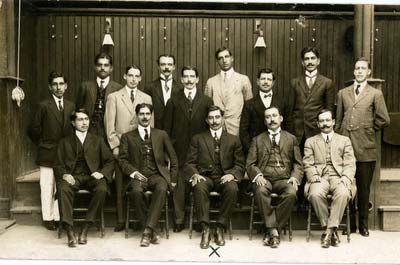The Huertistas in Guaymas
Huerta’s rule was never really effective in Sonora. From the middle of 1913 Obregón was master of all of the state, except GuaymasParadoxically, Guaymas had been against Díaz. When Madero visited Sonora on his political campaign, the merchants of Guaymas gave him an enthusiastic reception. One wealthy hacendado, José María Maytorena, became president of the Club Maderista, while Carlos Randall became tesorero. where General Pedro OjedaPedro Ojeda was born in Oaxaca. In 1911 he commanded the 14 Batallón de Infantería against the Maderista and was appointed a General Brigadier and in 1912 fought against the Orozquistas. He served as Jefe Político of the territory of Tepic. In February 1913 he had command of northern Chihuahua but his forces were defeated at Nogales and Naco and he had to take refuge in the United States. He was promoted to General de Brigada and reappeared in Guaymas in May 1913, as commander of the huertista División del Yaqui. He was promoted to Divisionario in December 1913, and handed over command to General Téllez in March 1914. He died in Mexico City in 1925. was besieged, with four thousand men of the División de YaquiThe title ‘División del Yaqui’ dates from 1 April 1913 when, by presidential decree, Huerta reorganised the military structure in the country and the Primera Zona Militar became the División del Yaqui, with its General en Jefe de Brigada, Pedro Ojeda, having his headquarters in Hermosillo. The Yaqui Indians in Sonora were generally strong adherents of Maytorena. "Yaqui Indians deported to Yucatan several years ago by order of Porfirio Díaz, when he was president of Mexico, and brought back to the vicinity of Guaymas a few months ago, have been forcibly drafted into the federal garrison. These have been deserting whenever the opportunity offered" (El Paso Morning Times, 4 July 1914), fourteen pieces of artillery and four machine-guns.
During this siege Huerta’s central government was unpunctual in paying the salaries and expenses of the División del Yaqui whilst the military high command exhausted its credit with the banks and commercial houses. Because of the impact on revenues the authorities resorted on 5 June 1913 to a tax on gabanzo production and on 9 December 1913 to a 5% emergency tax on properties and businesses. On 12 December the Sonoran governor, Francisco H. García, wrote to the Secretaría de Hacienda y Crédito Público and the Secretaría de Guerra that the absolute lack of money in Guaymas to pay the troops threatened dire consequences. He had managed to obtain $50,000 from businesses but asked to be allowed to use the funds in the Customs and other officesAGN, colección Manuel González Ramírez 93/37.
However the Federal government disallowed the emergency tax so when General Joaquín Téllez took over in March 1914 he authorized an issue of vales of the Tesorería General de la FederaciónIn 1929 the U. S. State Department, on behalf of the General and Special Claims Commissions, United States and Mexico, asked the American consuls to submit details of the various paper money decrees. The American consul in Guaymas, Herbert S. Bursely, reported that “M. Orteja, one of the signers of the Guaymas March 14, 1914 money, states that this money was issued under orders from Mexico City which had, throughout the life of the Huerta Government, communication with Guaymas by water. He states that the money was printed in Mazatlán. Mr. Ortega also states that no copies of the orders for this or the April 1, 1914 Guaymas money are obtainable in Guaymas, but that they probably exist in Mexico City. The Consulate has made extensive enquiries and has been unable to obtain any copies of the orders on question” (SD papers, 812.515/356).[text needed], which, he said, “if it is a tax it is very fair because it falls on all inhabitants, benefiting all commercial transactions, which are very difficult today because of the shortage of coins” AGN, Secretaría de Gobernación, leg. Autografos de Gobernadores, Edos. Servicio Seguridad Puestos. Comunicaciones. 1913-1914, exp. 220.
Provisional La Jefatura de Hacienda issue
On 28 March 1914 the steamer ‘Bonita’, carrying 900,000 pesos with which to pay the Guaymas garrison was captured and sunk by the Constitutionalists outside the portEl Paso Morning Times, 31 March 1914. Possibly as a result of this upsetHowever, Téllez arrived in March 1914. As he had already issued notes drawn on La Tesorería de la Federación in Saltillo, his arrival might have been the trigger., three days later the Jefatura de Hacienda issued an emergency series of notes (in values of ten centavos, fifty centavos and one peso) printed by C. D. Taylor e HijoCharles Douglas Taylor was born in New York in 1866 and came to Guaymas in the 1880s. He served for several decades as U. S. Consul in Guaymas and at the end of the century founded the printing company of “C. D. Taylor e hijo” which operated until the 1930s. He died in Los Angeles on 11 April 1919 in Guaymas itself. These were to be to be paid with the scrip that the Tesorería de la Federación would shortly be putting into circulation (pagará en cheques de los que a cargo de la Tesorería de la Federación circularán próximamente). They carried the names of C. Pérez Ojeda as Jefe de Hacienda and Modesto Ortega as Contador and had a rubber stamp signature of Joaquin C. Téllez.
| On 30 April 1913 C. Pérez Ojeda was Contador E. in Chihuahua and approved the monthly balance sheet of the Banco Comercial Refaccionario on behalf of the government InterventorPeriódico Oficial, Chihuahua, 1 June 1913. He then became Contador in the Jefatura de Hacienda in Chihuahua and when the city was under siege by revolutionaries in November 1913 signed an emergency issue. In a case of 'out of the frying pan, into the fire', he went on to be Jefe de Hacienda in Sonora and so besieged again in Guaymas. | |
|
Modesto Ortega Serrano was born in Puebla but moved to Guaymas with his wife Maria Sanders. During his life he tried various enterprises such as a nixtamal mill and cigarette factory without much success and at some time was a cajero for the Banco de México. He had a longtime interest in telecommunications and on 1 May 1938 began XEDR, the first radio station in Guaymas. He died on 14 July 1947El Diario, Guaymas, 14 July 1947. |
|
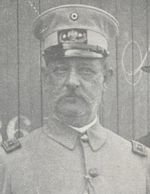
Joaquin C. Téllez was born in Mexico City in 1866 and entered the army as a Sargento 2o on 2 February 1881. He fought against the Yaquis and was at the peace talks celebrated on 15 May 1897. In 1910, as a Coronel, he commanded the 7o Regimiento in Chihuahua against the Maderistas and rose to Brigadier. Then in 1912 he fought the Orozquistas, commanded one of the Brigadas of the División del Norte and was made a General de Brigada. He was General-in-Chief of the División del Bravo (Bravo is the Mexican name for the Rio Grande), stationed in northeastern Mexico, originally to attack Villa’s División del Norte in its rear as it progressed into central Mexico and, after the United States landing at Veracruz, to deter an invasion through Brownsville, Texas and Matamoros. Cut off from Mexico City, this Federal unit was forced to issue its own paper money at Saltillo in January 1914, drawn on La Tesorería de la Federación. Téllez was transferred to Guaymas in March 1914 and assumed duties as Provisional Governor of the State of Sonora and commander of the División del Yaqui. |
This photograph is of the División del Yaqui, with the paymaster (pagador) marked with an 'X'.

 M3807 10c La Jefatura de Hacienda
M3807 10c La Jefatura de Hacienda
Both 50c and $1 values appear in two types; with or without a large ‘A’ in the upper centre of the underprint. The two types also use different typefaces, most noticeable in the word ‘Pagará’.
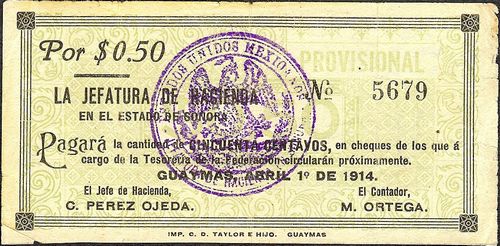
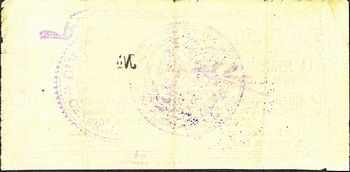
M3808a 50c La Jefatura de Hacienda without "A"
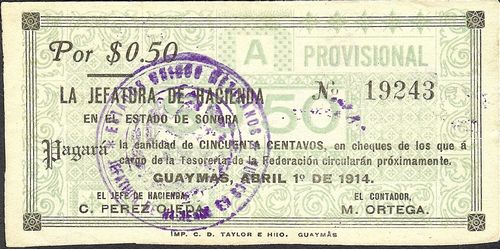
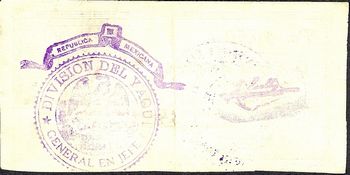
M3808b 50c La Jefatura de Hacienda with "A"
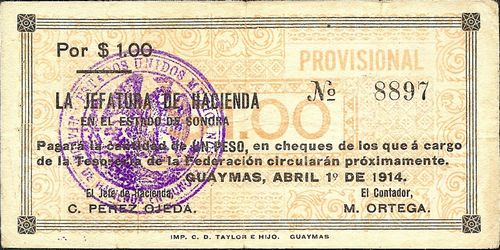
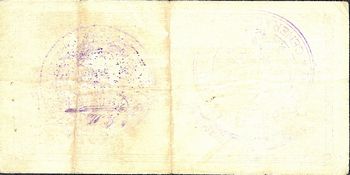
M3809a $1 La Jefatura de Hacienda without "A"

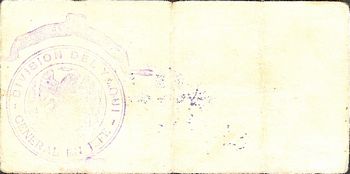
M3809a $1 La Jefatura de Hacienda with "A"
| from | to | total number |
total value |
|||
| 10c | 0001 | 99999 | 100,000 | $ 10,000 | includes numbers 9451 to 44086 | |
| 50c | without A | 0001 | 99999 | 100,000 | 50,000 | includes numbers 5679 to 97971 |
| with A | 0001 | 99999 | 100,000 | 50,000 | includes numbers 21879 to 87980 | |
| $1 | without A | 0001 | 99999 | 100,000 | 100,000 | includes numbers 8897 to 94069 |
| with A | 0001 | 99999 | 100,000 | 100,000 | includes numbers 5526 to 80737 | |
| $310,000Jorge Murillo Chisem, Apuntes para la Historia de Guaymas, Sonora, 1990 states that known numbers suggest there were 100,000 of each value, a total of $160,000 pesos’ worth but he seems to have been unaware of the two types. |
The ‘ESTADOS UNIDOS MEXICANOS - JEFATURA DE HACIENDA EN SONORA’ seal on the front of the 50c is known in two different sizes (37mm and 40mm) and in both blue and purple ink.
As for the reverse, there are two different versions of the ‘DIVISION DEL YAQUI’ seal, one with a simple and the other with a serrated edge.

simple seal
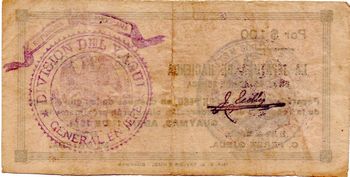
serrated seal
The $1 note is also known with a seal 'JEFATURA DE HACIENDA EN SONORA, CONTADURIA' instead of/as well as the ‘ESTADOS UNIDOS MEXICANOS - JEFATURA DE HACIENDA EN SONORA’ seal. This might have been applied when amortised.
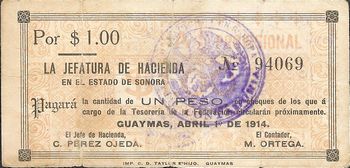
M3809a $1 with 'JEFATURA DE HACIENDA EN SONORA, CONTADURIA'
La Tesorería de la Federación issue
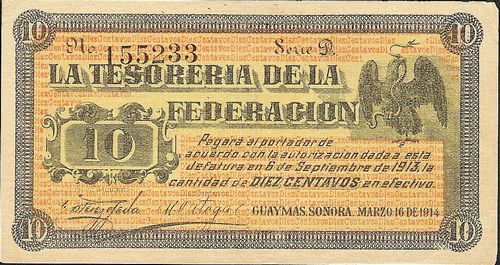
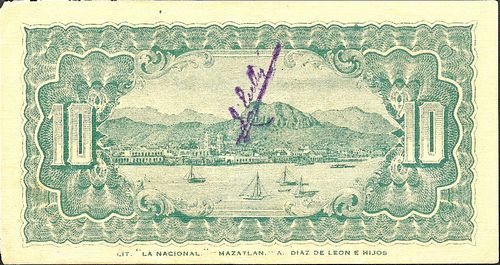 M3802 10c La Tesorería de la Federación
M3802 10c La Tesorería de la Federación

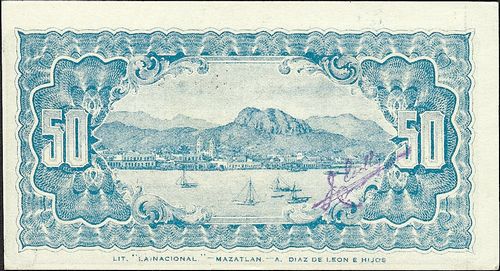 M3803 50c La Tesorería de la Federación
M3803 50c La Tesorería de la Federación
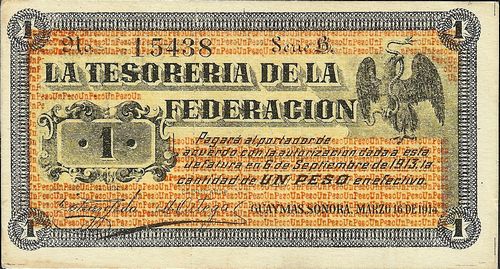
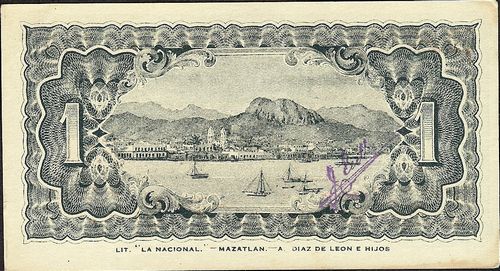 M3804 $1 La Tesorería de la Federación
M3804 $1 La Tesorería de la Federación
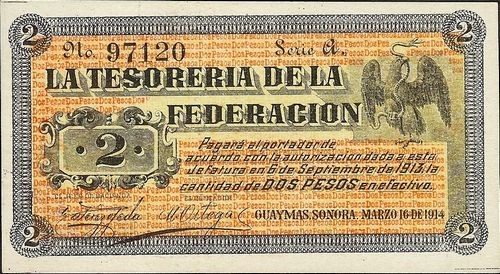
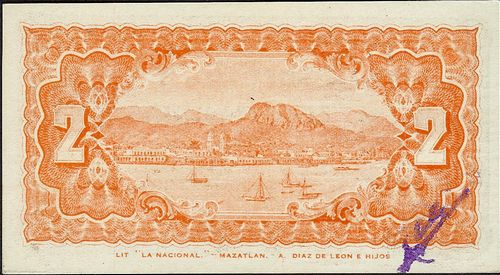 M3805 $2 La Tesorería de la Federación
M3805 $2 La Tesorería de la Federación
| Series | from | to | total number |
total value |
||
| 10c | D | 1 | 1000000 | 1,000,000 | 100,000 | includes numbers 47721CNBanxico #6261 to 647537CNBanxico #6255 |
| 50c | C | 1 | 100000 | 100,000 | 50,000 | includes number 11704CNBanxico #6264 to 92338CNBanxico #6265 |
| $1 | B | 1 | includes numbers 15438 to 147369CNBanxico #6270 | |||
| $2 | A | 1 | 100000 | 100,000 | 200,000 | includes numbers 7110CNBanxico #12093 to 97120 |
| $ 500,000 |
The definitive issue of the Tesorería de la Federación, printed by the ‘La Nacional’ press, owned by the firm of A. Díaz de León e hijo in Mazatlán, were dated 16 March but presumably issued later. They were also signed by Pérez Ojeda and Modesto Ortega.
Téllez reported that the issue was to be of $500,000 AGN, Secretaría de Gobernación, leg. Autografos de Gobernadores, Edos. Servicio Seguridad Puestos. Comunicaciones. 1913-1914, exp. 220. The American consul in Mazatlán also reported that $500,000 printed there was being sent to Guaymas (SD papers, 812.515/19 telegram Alger, Mazatlán to Secretary of State 27 March 1914). These notes also carry the rubber-stamped validating signature of Joaquin C. Téllez on the reverse. The 10c is usually without the signature and a 10c with signature is rare: the other denominations are not known except with the validation. The 10c is known on board or thin card (common) and also on paper (very rare)Ken Tabachnick has pointed out that some of the 50c notes were renumbered with small thick numbers printed over the regular numbers. In each instance the second number is higher than the first..
Use in other states
Sinaloa
These notes also circulated in Mazatlán, Sinaloa, as on 18 May the local paper said that as people might decline to accept them holders could also take them to the Tesorería General del Estado, where they would be exchanged for banknotes or Mazatlán’s own Huertista issueEl Correo de la Tarde, Mazatlán, 18 May 1914. On 23 May it reported that the provisional Jefatura de Hacienda notes would be exchanged in the Tesorería General up to twelve noon the next day, whereupon they would be returned to Guaymas on the steamship 'Herrerías' which was sailing that dayEl Correo de la Tarde, 23 May 1914.
A 10c note is known with a circular red resello 'BRIGADA OBREGON - R 1915 - SAN BLAS DIV.' but it appears suspicious.

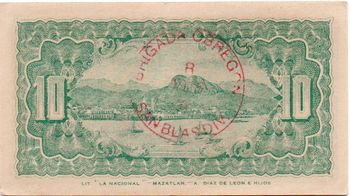
M3802 10c with 'BRIGADA OBREGON'
This resello is also known on Chihuahuan dos caritas.
Baja California
These notes also spread to the Federal-held sections of the Baja peninsula. On 2 June 1914 Téllez wrote to the Prefecto Político in La Paz that he had issued these vales drawn on the Tesorería de la Federación, and wanted the Prefecto Político to ensure that they circulated in his districtABCS, Hacienda, vol. 624bis, exp. 34. The next day Téllez repeated his request to the Jefe Político in La Paz who, on 5 June, transmitted it to the Subprefectos of San José del Cabo and Triunfo and the Presidentes Municipales of Todos Santos and Santiagoibid.. The Presidente Municipal of Todos Santos and Subprefectos Políticos of San José y Santiago and of El Triunfo had copies of Téllez’ decree postedibid..
On 12 June the authorities in Guaymas told the Subprefecto Político in Mulegé, Baja California, to ensure that the notes were of compulsory circulation and accepted in public officesibid..
On 15 June the Jefe Político of La Paz replied that they were already in circulation and asked for funds in the same form to cover his administrative expenses since the amount that Pagador Serrano brought was only for Tte. Coronel Gutiérrez’s columnibid..
Most, however, were used in the besieged town and the Federal soldiers there were said to be demoralised because they received their pay in a scrip that was only good in GuaymasEl Paso Morning Times, 4 July 1914.
Withdrawal
On 11 June a Mexico City newspaper reported that the provisional issues of Guaymas and Mazatlán were being exchanged in the Jefatura de Hacienda for banknotes sent for that purpose from Mexico CityEl Imparcial, 11 June 1914 but this seems to have been little more than propaganda.
On 17 July the División de Yaqui evacuated Guaymas. Five days later it disembarked at Manzanillo, Colima. Téllez was ordered to disband the division in compliance with the negotiations between Huerta and the Constitutionalists but instead he reembarked for Salina Cruz and left his men there, heading himself for Central America.
These Federal soldiers will have taken their notes with them as it was the only currency that they had and it was not a foregone conclusion that the incoming government would disown it. Once they were demobilised they began to try and spend their notes. Hence there is an example of a 50c note[image needed] with a resello from the Comisaria de Policia in Salina Cruz.
In San Jerónimo, 180 kilometres west of Salina Cruz, these notes were used to pay public officials, including Marcelino Carrizosa, the school director. On 15 February 1915 Carrizosa was part of a commission that went to the capital and Carranza agreed to exchange the $41 that Carrizosa had received. However, the Secretaría de Hacienda did not comply and Carrizosa was obliged to write to Carranza again on 30 MarchCEHM, Fondo XXI Venustiano Carranza, carpeta 33, legajo 3558.
On 31 July 1914 the Interim Presidente Municipal of Guaymas, Matías F. Alsua, decreed that the Constitutionalist issues were of forced circulation. On 5 August he decreed[text needed] that, to put an end to any doubt, he was confirming that Carranza's decree núm. 21 of 28 February 1914, that declared the Constitutionalist currency to be obligatory tender, remained in forceAGHES, Fondo Oficialidad Mayor, tomo 2993. By implication he was stating that the Federal currency, if not actually illegal, was at least not obligatory.
On 14 September a correspondent from Tehauntepec, Oaxaca, reported that the ex-federal soldiers there had brought large quantities of these notes with themEl Democrata, September 1914.
On 18 September, in response to a telegram, the Presidente of the Junta Municipal of Manzanillo, Colima, sent a list of the bonos that the ex-federals had left when they stopped there, which had been exchanged for giros on the Tesorería de la Federación. On 10 September a Señora Juana Espinosa had complained to the governor and was allowed to pay into the local office $24.30 in Téllez’ bonos AHEC, leg. 847, 1914.
On 5 October the Tesorero Municipal of Morelia, Michoacán, told the Presidente Municipal that some people were accepting the notes whilst the Administración del Timbre was refusing them. He asked for advice as he did not know of any official disposition and did not want to run the risk of losing moneyAHMM, caja 29, exp. 114 letter of Norberto Páramo, Tesorero Municipal to Presidente Municipal, Morelia, 5 October 1914. On 31 October 1914 the Prefecto of Morelia issued a circular (núm. 115) that the bonos issued by Huerta’s government were also of forced circulation, and though this will have referred to the Obligaciones Provisionales, it might have been understood as referring to these notes as well. This was copied to the Tesorero Municipal on 10 NovemberAHMM, caja 29, exp. 61. On 13 November the Prefecto issued another circular (núm. 123) that the state government had stated that all notes that were of forced circulation would continue to be so until new orders. These circulars were sent to the surrounding districtsAHMM, caja 29, exp. 61. Sent to the Jefes de Tenencia in Chiquimitio, Atécuaro, Tarímbaro, Tacícuaro, Teremendo, Capula, Cuto de la Esperanza, San Nicholás, Jesús del Monte, San Miguel del Monte, Santa Maria, Charo, and Santiago Undameo, 17 November 1914.
On 15 October it was reported that certain paymasters of the Constitutionalist army paid off some of their soldiers with Guaymas notes and would be punished for fraudThe Mexican Herald, 15 October 1914. This probably refers to Guadalajara where these notes threatened to cause serious damage to business and the general public. Some people claimed that the money would be exchanged by the Secretaría de Hacienda, and on 16 October certain paymasters in the Constitutionalist army paid their troops with it, though probably not because they considered it legitimate but because they were defrauding their own men. The Subsecretario de Hacienda, José J. Reynoso, had to warn soldiers to be on their guard as these vales were null and voidBoletin Militar, 17 October 1914. On 23 October the new Secretario de Hacienda in Mexico City, in a circular giving the legal status of various currencies, proclaimed that ‘the paper money issued in Guaymas by the Federal troops during the Huerta regime lacked any value’.
The 50c is known with a poorly legible overprint ‘COMANDANCIA DE PO[LICIA ]’[image needed].

